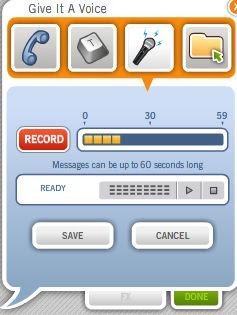Vokis are great for practising pronunciation, particularly sentence stress and intonation, plus all question forms.
Creating an animated character is real fun to do and gives both you and your students the opportunity to unashamedly exaggerate what your character has to say.
To create a Voki, you will need a microphone attached to the computer(s) that you're going to use. (I use a very cheap one that comes with my headphone set).
Creating an account
Create an account with Voki beforehand and get your students to use your login or, if you have time, they can create a new account for themselves.
Instructions for your students:
- Go to www.voki.com and sign in.
- Click on Create

- Now Customize your character
- You can change character, change his/her hair, clothes and accessories
- When you like your character, click on DONE
 2. Recording your character's voice
2. Recording your character's voice- Now you're ready to Give It A Voice. Click on the microphone

- When this dialogue box appears, check Permit and then click on Close

- Click on RECORD and now record what you want to say
- If you like your recording, click on SAVE. If you don't like it, just record again.

- Give your audio a title (very important)
 3. The final touches
3. The final touches- Choose a Background

- Choose a Player

- Now click on PUBLISH and give your scene a title (very important)
 4. Embedding your voki character in your class blog
4. Embedding your voki character in your class blog- Now create a new post on your class blog. Give it a title
- Back on the Voki site, select and copy the code that's displayed

- Back on your class blog posting, click on the Edit Html tab and paste the code you copied from Voki

- And enjoy the results!
Voki tasks for your classes
- A simple, initial first step is for your students to introduce their characters using a model like this :
They call me .... because ... (student thinks of a reason).
I love ... (student thinks of something their character loves doing).
I hate ... (student thinks of something their character hates doing)."
Once your students have presented their characters, they can pair up and conduct a question and answer session.(Important: to do this they will need to remember the settings they used when they created their character):
- First, they listen to their partner's character's introduction
- Then they think of one or two good questions to ask him/her
- Now they take turns in recording their characters' questions and answers
- Finally, they create a new posting on the class blog blog and paste the code for the questions and answers in the same posting so that they form a conversation
Conversation - Hilary + Wonder
Conversation - Michael + Yogi
While your students are working tasks like these, take the opportunity to listen with them each individually to their recordings. Being able to stop and start the sound is a great aid for focussing on any particular problems they may be having with individual sounds, word/sentence stress or intonation.
Moreover, if your students publish their vokis regularly on their class blog, you will have a handy record of their speaking capabilities and be able to measure their advances during the course.




1 comment:
hello!
your voki are fantastic! i especially love the kids' usage... i work for voki and we love seeing all of the great voki from around the world!
also, i wanted to feature some of the ones that you have on your page as our voki of the day! please email me at hannah@oddcast.com if you are interested!
thanks so much for using voki, keep it up!
hannah
Post a Comment